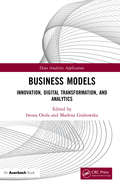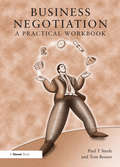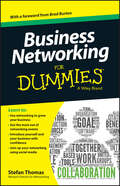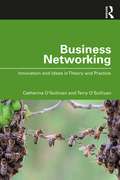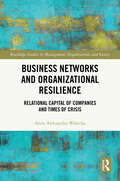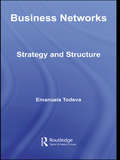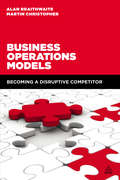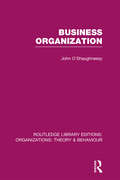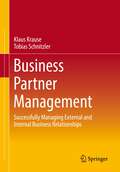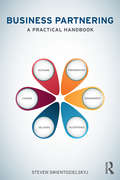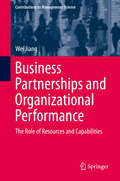- Table View
- List View
Business Models: Innovation, Digital Transformation, and Analytics (Data Analytics Applications)
by Iwona Otola Marlena GrabowskaSince the beginning of time, running a business has involved using logic by which the business operates. This logic is called the business model in management science, which increasingly is focusing on issues surrounding business models. Research trends related to business models include value creation, value chain operationalization, and social and ecological aspects, as well as innovation and digital transformation. Business Models: Innovation, Digital Transformation, and Analytics examines how innovation, digital transformation, and the composition of value affect the existence and development of business models. The book starts by addressing the conceptual development of business models and by discussing the essence of innovation in those models. Chapters in the book investigate how: Business models can analyze digital transformation scenarios Individual business model elements effect selected performance measures as well as how the elements are significant for the enterprise value composition The environment effects the profitability of the high-growth enterprise business models Employer branding business models are perceived by the generation Z workforce To implement responsible business models in the enterprise Cyber risk is captured in business models Decision algorithms are important to business analytics This book is a compendium of knowledge about the use of business models in the context of innovative activities, digital transformation, and value composition. It attempts to combine the theory and practice and offers a look at business models currently used in companies, especially high-growth enterprises, in various countries of the world and indicates the prospects for their development.
Business Negotiation: A Practical Workbook
by Tom Beasor Paul T SteeleGetting to grips with negotiation quickly is straightforward and easy with this practical guide. Written in simple language, with a host of practical exercises to support the text, it is designed for any negotiator who wants to develop their knowledge, increase confidence and develop skills. Starting by demonstrating the importance negotiation plays in both commercial and interpersonal relationships, Business Negotiation then takes the reader through 20 developmental steps which cover: objective setting and planning; the first phases of negotiation; managing movement; and completing the deal. Each step features a knowledge and skill building exercise, tips and techniques including: ¢ Example scripts ¢ Negotiation tactics ¢ Practical exercises ¢ Dilemmas and suggested solutions ¢ Key points. In a highly interactive style, this book provides a learning route to skilled negotiation. Written by experts in the field of negotiation, it gives a clear picture of all aspects of the subject and arms the reader with a wealth of ideas and examples for their next negotiation.
Business Negotiations and the Law: The Protection of Weak Professional Parties in Standard Form Contracting (Young Feltrinelli Prize in the Moral Sciences)
by Carlotta RinaldoBusiness Negotiations and the Law: The Protection of Weak Professional Parties in Standard Form Contracting aims to explore the issues surrounding contract negotiations between entrepreneurs and other professionals when one of the parties does not have the same level of bargaining power as the other. The need to protect weaker parties from unfair contract terms exists not only in relationships between businesses and consumers, but in business to business contracts also. This book focuses on the problem of small enterprises, independent contractors and other professional weak parties and examines these from a European point of view. There are significant differences between Member States as to decisions regarding regulatory context on the protection of weaker professional parties in asymmetrical contractual situations. However, European businesses are overwhelmingly smaller in size, so protecting weaker parties becomes key in facilitating successful and efficient negotiations. The book provides a critical and comparative overview of the area and recent regulatory developments, both to clarify the direction that European legislation is heading, and to explore the tools needed to assure the effectiveness of the common market. This text will be of interest to policy makers, researchers of European legislation, and students of commercial and business law.
Business Negotiations in China: Strategy, Planning and Management
by Henry K. WangBusiness Negotiations in China provides a holistic overview of the institutional, organisational and cultural issues that underpin successful business negotiations in China. Good negotiation strategies and management are essential for establishing successful business deals and new ventures in China. The author addresses the current key issues and risks, high level business management, planning, innovative approaches and modern negotiation strategies. The text opens with a review of the evolution of key negotiation models that have been use in China right up to the most current. This is followed by an analysis of the various negotiation frameworks and processes being undertaken in China; their similarities and differences with other global negotiation processes. Alongside the negotiation itself, the author provides advice on: selection of the negotiation team and the various strategic roles within it; the detailed preparations and analysis required prior to starting negotiations in China; effective management strategies for each of the various stages of negotiation to achieve successful, sustainable outcomes. Business Negotiations in China is supported by examples and analysis drawn from actual high level business negotiations by leading international companies with China State Owned Enterprises. It also explores the fierce competition between multinationals and China state-owned companies and their respective different negotiation strategies. This book is an important, indispensable insider’s guide to the strategy and practice of negotiating in China and is relevant to professionals, academics, researchers and students alike.
Business Networking For Dummies
by Stefan ThomasGrow your business, build your career, find more customers, and build a valuable support network of likeminded business people. Networking is a crucial skill for all professionals and business owners. Quite simply, it’s a fast and effective way to build your business or career - and excellent networking skills will set you apart from the competition. Business Networking For Dummies shows you how to get the most out of networking - both online and offline. With Business Networking For Dummies, you’ll learn to: Use business networking to grow and develop your business Find the right platform or platforms to build your own network and ‘assemble your crowd’ Pitch yourself and your business with confidence Get the most out of face-to-face networking events - including valuable tips on presentation skills and sound bites! Join up your ‘real life’ and online networking Measure your networking success Follow up with new contacts successfully “This is a cornerstone book for anyone involved in running a smaller business and wishing to deploy networking as an enquiry source. It is clear, concise and provides a complete education for succeeding in, what is for some, a difficult environment." Ben Kench, Leading UK sales trainer and business growth specialist "I’ve read this entire book from start to finish and so should you because, when you know what you’re doing, business networking does work, and by following the blueprint that Stef has set down for you: first you’ll learn, then you’ll earn.” Brad Burton, Managing Director, 4Networking Ltd.
Business Networking and Sex
by Ivan Misner Hazel M. Walker Frank J. De Raffelle JrIt's no surprise that communicating with the opposite sex can be tricky. Hidden in the glitches are often misleading assumptions about each gender that beg for help. Finally, help is here.Learn the secrets to accurately reading between the gender lines, and uncover a new edge for your business-the power to effectively talk business and successfully network with the opposite sex.
Business Networking: Innovation and Ideas in Theory and Practice
by Terry O'Sullivan Catherine O'SullivanThe term ‘networking’ can mean very different things in different contexts: formal organisational structures, personal or career development, or a technique for increasing sales. This is an approachable book which brings together the basics of all these meanings, underpinned by an overview of multiple theoretical models that support the various approaches to networking. Drawing on mainstream models in the fields of marketing, employability, innovation and organisational studies, Business Networking provides an integrated overview of the process and structure of networking across a range of contexts. Synthesising theory with practice, features include examples and viewpoints from a range of networking practitioners in each chapter, presented in their own words, as well as chapter summaries and reflective questions. Networking is considered a key skill for students, entrepreneurs and practitioners and, given the explosion of opportunities brought by the digital age for individuals and organisations to operate within a broad and global network, an introduction to maximising the benefits is timely. This book should be recommended reading for a broad range of postgraduate courses, from relationship marketing and entrepreneurship skills to employability and degree apprenticeship programmes. It should also be useful for reflective practitioners looking to expand and utilise their networks effectively.
Business Networks Reloaded
by Stefanie Jung Peter KrebsBusiness networks are an important economic phenomenon of increasing practical importance throughout Europe. This volume examines business networks from an interdisciplinary perspective, with many contributions dealing with a certain form of business network, the so-called cooperative or non-hierarchical. With regard to this specific form of cooperation the volume presents new economic findings, proposes a definition and discusses the governance structure of those networks.Moreover, this book explores whether the research results can also be applied to hierarchical, centralized business networks. With medium-sized companies and all the more with large companies, business networks also pose the question of the compatibility with anti-trust law. This collection dedicates three contributions to this important question. They are complemented by chapters on liability of the network and its members towards third parties and contributions discussing duties of loyalty and the interpretation of agreements. Drawing on new research from Italy, Spain, Germany and Norway, this work illustrates the European legal perspective on business networks.
Business Networks and Organizational Resilience: Relational Capital of Companies and Times of Crisis (Routledge Studies in Management, Organizations and Society)
by Anna Aleksandra WaleckaBusiness Networks and Organizational Resilience: Relational Capital of Companies and Times of Crisis is a comprehensive monograph that investigates the interplay between a company’s relational capital and its ability to withstand and rebound from crises.Drawing on theoretical frameworks and empirical research, this book explores how relational capital influences organizational resilience in times of adversity, offering valuable insights for both scholars and practitioners. Through a blend of original research and empirical analysis conducted in two stages – the initial study in 2018 and its validation in 2024 – this monograph uncovers the intricate relationship between a company’s relational capital and its resilience to turbulent circumstances.Readers will gain a deep understanding of the fundamental role of relational capital in crisis management and learn practical strategies for enhancing organizational resilience. The book provides actionable recommendations for measuring and managing relational capital effectively, equipping readers with the tools they need to safeguard their organizations from potential crises and navigate challenges with confidence.This book is essential reading for scholars and researchers seeking to deepen their understanding of relational capital and crisis management. Business practitioners, including entrepreneurs and organizational leaders, will also find valuable insights and actionable recommendations for improving organizational resilience. With its practical guidance and scholarly rigor, this book serves as a valuable resource for anyone interested in the intersection of relational capital and crisis management, bridging the gap between theory and practice in this critical area of study.
Business Networks in Clusters and Industrial Districts: The Governance of the Global Value Chain (Regions and Cities)
by Alessia Sammarra Fiorenza BelussiDuring the 1980s the Marshallian concept of industrial district (ID) became widely popular due to the resurgence of interest in the reasons that make the agglomeration of specialised industries a territorial phenomenon worth being analysed. The analysis of clusters and IDs has often been limited, considering only the local dimension of the created business networks. The external links of these systems have been systematically under-evaluated. This book offers a deep insight into the evolution of these systems and the internal-external mechanism of knowledge circulation and learning. This means that the access to external knowledge (information or R&D cooperative research) or to productive networks (global supply chains) is studied in order to describe how external knowledge is absorbed and how local clusters or districts become global systems. It provides a unified approach; showing that existing capabilities expand when locally embedded knowledge is combined with accessible external knowledge. In this view, external knowledge linkages reduce the danger of cognitive ‘lock-in’ and ‘over-embeddedness’, which may become important obstacles to local learning and innovation when technological trajectories and global economic conditions change. A selection of international experts
Business Networks in Syria
by Bassam HaddadCollusion between business communities and the state can lead to a measure of security for those in power, but this kind of interaction often limits new development. In Syria, state-business involvement through informal networks has contributed to an erratic economy. With unique access to private businessmen and select state officials during a critical period of transition, this book examines Syria's political economy from 1970 to 2005 to explain the nation's pattern of state intervention and prolonged economic stagnation. As state income from oil sales and aid declined, collusion was a bid for political security by an embattled regime. To achieve a modicum of economic growth, the Syrian regime would develop ties with select members of the business community, reserving the right to reverse their inclusion in the future. Haddad ultimately reveals that this practice paved the way for forms of economic agency that maintained the security of the regime but diminished the development potential of the state and the private sector.
Business Networks: Strategy and Structure (Routledge Studies in Business Organizations and Networks #Vol. 37)
by Emanuela TodevaAlthough social, political, technological and business networks hold our modern world together, we still lack a good understanding of what business networks are, how they work, and the language of network analysis that we may apply to solve common, everyday problems. This book looks at such questions as: How do we make sense of the business networks we participate in and the networks we observe from a distance? Are business networks distinct from social networks, and if so what distinguishes them? How can business network analysis from a multidisciplinary perspective enhance strategic management? Emanuela Todeva deftly explores the patterns of networking and the dynamics of network relationships, to show how we can begin to tap their full potential. Of great interest to students and scholars of business network analysis, this revealing volume will also prove informative for managers wishing to obtain insights into network dynamics and its implications for strategic decision making. Business Networks expertly provides an interdisciplinary overview. It skilfully engages the reader with a range of economic, sociological, strategic management and communication theories that contribute to our knowledge of networks and networking. Transcending specific disciplines, and synthesizing the contributions that shape the structural, relational and cultural approaches to network analysis, Todeva’s outstanding text offers a wealth of conceptual frameworks and an exhaustive typology of existing business networks.
Business Notes: Writing Personal Notes That Build Professional Relationships
by Florence IsaacsIn today's high-tech business world, where we all rely heavily on voice mail, E-mail, and faxes, we can't underestimate the value of a personal note, even if it's only a few lines. In fact, many successful executives refer to personal notes as their "secret weapons. " Whether you're writing to follow up on a sales call or job interview, congratulate a colleague on a recent promotion, reach out to a client with whom you've lost touch, or express your condolences to a co-worker, personal notes can build and strengthen important relationships in the professional world. With hundreds of ideas and sample notes to provide inspiration, Business Notes will help you craft an appropriate message for any situation. Book jacket.
Business Operations Models
by Martin Christopher Alan BraithwaiteMost successful companies have operations management at their heart. It should enable strategy and should be part of boardroom discussions. However, Cranfield research has shown that business strategy barely recognises the world of operations management. Recognising that operations management needs to be more strategic, Business Operations Models is a revolutionary new title that looks at the interrelationship of operations management and strategy. In Business Operations Models, Martin Christopher and Alan Braithwaite identify the characteristics of market-leading businesses that have transformed their markets and delivered super performance for their stakeholders. It points to the theory gap between strategic thinking and operations and how many high-performing businesses arrive at their new operating models as much by chance as judgement. Unpacking those observations leads to some clearly defined features of winning competitors, including eliminating waste, leveraging technology, and utilising transformative business models. Business Operations Models offers a framework for achieving super performance and understanding when and how a company may be able to leverage its capabilities to outperform. The book provides detailed international case studies that illustrate how the principles work in practice, including Apple, Dell, Amazon, John Lewis, Southwest airlines, Aldi, Toyota and many others.
Business Opportunities and Risks in China: Strategies and Recommendations from a European Perspective (Management for Professionals)
by Marc Helmold Tracy Dathe Volker MüllerThe rise of China poses a significant challenge to the existing, Western-dominated world economic order. The effectiveness of the Regional Comprehensive Economic Partnership (RCEP) is contingent on a smooth transition of the world’s economic center toward the Asia-Pacific Region. For Western investors, the vast market opportunities can be tempting. However, the lack of experience and knowledge of international management in China – a country with radically different business rules and cultural background – poses a substantial risk. This book provides comprehensive insights into the fast-changing business world in China. Based on the authors’ theoretical knowledge and invaluable years of practical experience, it discusses the various options for doing business in China, with current examples that demonstrate how European SMEs can successfully position themselves between multinational companies and local competitors. It also highlights new opportunities arising from China’s international involvement (New Silk Road, RCEP) and addresses risk management for European SMEs operating in China. Moreover, it sheds light on how to form relationships of mutual trust between Chinese policymakers and their advisors/cooperation partners from abroad. Readers with an interest in doing business in China will find this book particularly valuable.
Business Opportunities in the Pacific Alliance: The Economic Rise of Chile, Peru, Colombia, and Mexico
by John E. Spillan Nicholas VirziThis book provides a solid overview of trade and business opportunities in the Pacific Alliance, focusing on the key drivers of economic growth and development in Chile, Peru, Colombia, and Mexico. It addresses the political, economic, and social benefits that accrue when commerce and markets are made freer, and implications this poses for American businesses. Further, it surveys how key economies of Latin America have learned from past failures and are poised to capitalize on them in the future. It will offer a detailed understanding for business scholars, practitioners, and entrepreneurs looking to explore new business ventures in dynamic trade union.
Business Optimization Using Mathematical Programming: An Introduction with Case Studies and Solutions in Various Algebraic Modeling Languages (International Series in Operations Research & Management Science #307)
by Josef KallrathThis book presents a structured approach to formulate, model, and solve mathematical optimization problems for a wide range of real world situations. Among the problems covered are production, distribution and supply chain planning, scheduling, vehicle routing, as well as cutting stock, packing, and nesting. The optimization techniques used to solve the problems are primarily linear, mixed-integer linear, nonlinear, and mixed integer nonlinear programming. The book also covers important considerations for solving real-world optimization problems, such as dealing with valid inequalities and symmetry during the modeling phase, but also data interfacing and visualization of results in a more and more digitized world. The broad range of ideas and approaches presented helps the reader to learn how to model a variety of problems from process industry, paper and metals industry, the energy sector, and logistics using mathematical optimization techniques.
Business Organization (Routledge Library Editions: Organizations)
by John O'ShaughnessyThis book presents an integrated view of the three main approaches to organization – classical, human relations and systems – showing what each has of value to contribute and how they complement each other. The three approaches are introduced, followed by critical analysis. The main classical problems are reviewed in the light of the systems approach. Finally there is a comparative summary in tabular form, an illustrative systems study and a decision schedule.
Business Organizations
by Theresa A. Gabaldon Christopher L. SagersBusiness Organizations, Third Edition is a pedagogically rich book that recaptures student engagement in the course without sacrificing basic rigor. The traditional coverage of most books in the field is retained, but modernized in reflecting the importance of unincorporated entities and small business counseling problems. Transaction-oriented problems put the student in the practice role of advising a variety of businesses. An expository approach provides clear context for cases. <p><p>Features include flowcharts, connections boxes, self-testing exercises, an interspersed series of exercises on ethics for business lawyers, a glossary of terms, and sidebars on numerical concepts and skills. Through the use of sidebar explanations or otherwise, the chapters or major sections of chapters in the book stand alone, facilitating teaching in almost any order. An online supplement includes a “business concepts for lawyers” module to be assigned as an instructor desires, as well as a variety of sample documents to show students the actual materials that lawyers work with every day.
Business Organizations For Paralegal (Aspen Paralegal Series)
by Deborah E. BouchouxBusiness Organizations for Paralegals, Ninth Edition
Business Owners Who Are Blind or Visually Impaired
by Deborah KendrickThe second title in the exciting Jobs That Matter series written by an award-winning blind journalist, Business Owners Who Are Blind or Visually Impaired demonstrates the wide range of careers and talents that can be pursued by persons with visual impairments. Each profile features a successful individual who has accomplished his or her dream of business ownership and who shares important insights. From a lawyer and an accountant to a florist and a gourmet cook, the range of engaging stories told will inspire young adults with visual impairments and the parents, teachers, and counselors who advise them.
Business Partner Management: Externe und interne Geschäftsbeziehungen erfolgreich gestalten
by Klaus Krause Tobias SchnitzlerDieses Fachbuch gibt einen strukturierten, branchenunabhängigen und zugleich praxisnahen Einblick in alle Arten geschäftlicher Partnerschaften. Sowohl die Beziehungen zu externen Geschäftspartnern als auch die internen Partnerschaften mit Kollegen und Mitarbeitern werden eingehend betrachtet. Die Autoren führen durch alle Phasen dieser Partnerschaften, beleuchten die unterschiedlichen Aspekte und bieten erprobte Methoden und Praxistipps für die erfolgreiche Arbeit mit Partnern. Im Vordergrund steht der Mensch als Partner und Individuum mit Interessen und Zielen. Der Vergleich zu privaten Partnerschaften ist dabei durchaus gewollt und veranschaulicht die Ausführungen. Erkenntnisse aus der Hirnforschung, zum Lernen und zu Kooperationen werden ebenfalls einbezogen.
Business Partner Management: Successfully Managing External and Internal Business Relationships
by Klaus Krause Tobias SchnitzlerThis professional book provides a structured, industry-independent and at the same time practical insight into all types of business partnerships. Both relationships with external business partners and internal partnerships with colleagues and employees are considered in depth. The authors guide you through all phases of these partnerships, highlighting the different aspects and offering proven methods and practical tips for working successfully with partners. The focus is on people as partner and individual with interests and goals. The comparison to private partnerships is quite intentional and illustrates the explanations. Findings from brain research, learning and cooperation are also included.
Business Partnering: A Practical Handbook
by Steven SwientozielskyjA Business Partner is a professional who supports and advises strategic and operational decision-making through insights that drive better business performance. Often as a result of external changes, business partners must respond quickly to map out the future strategic development, keep the firm competitive and ensure all objectives and legal requirements are met. In this book, business partnering expert Steven Swientozielskyj introduces a framework that provides a set of practical tools and techniques via a simple six stage model that, when replicated, will take the practitioner from start to finish through strategic change; from the formation and agreement of the strategy to its delivery and sustainability. Business Partnering is a one-stop shop for understanding this important phenomenon and as such will be vital reading for practitioners and academics in the business arena.
Business Partnerships and Organizational Performance: The Role of Resources and Capabilities (Contributions to Management Science)
by Wei JiangIn the rapidly changing business world, only a small percentage of firms are able to survive and prosper despite recessions, industrial evolutions and economic changes. An often-asked question is: What determines a firm's sustainable competitive advantage? One of the most popular competitive strategies is partnering with other firms. So: How do firms make intelligent and informed decisions when it comes to selecting business partners, to utilizing available resources and capabilities in partnerships, and to managing relations to maximize partnership benefits? This book studies 300 firms across various industries, providing readers with a comprehensive view of how firms develop sustainable competitive advantages by establishing business partnerships. Young academics and experienced researchers alike will find solid theoretical foundations and fresh business insights.
